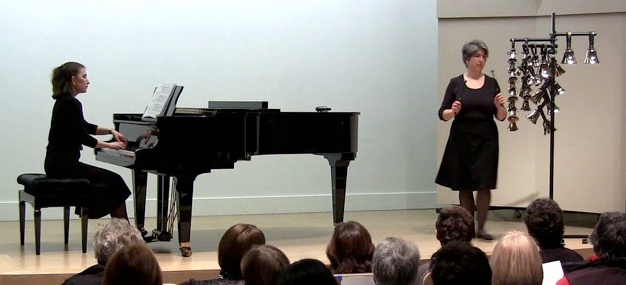I was flattered when someone complimented my musicality on a recent bell tree video of Linda Lamb’s gorgeous Celtic Farewell. That started me thinking about the elements of musicality in bell trees, and some ideas that have helped me move toward a more musical performance. Some of these elements also apply to bells played from the table.
Training – It’s impossible to teach yourself a skill as effectively as an expert would. Working with a percussion coach, together with weekly coaching from my accompanist, has had a huge impact on my progress. Many of these ideas I learned from them, and there’s still much to learn.
Equipment:
Organization of trees – Keeping the strands at or below eye level, with all the bells arrayed in front of the pole, allows me to see what I’m hitting. This improves accuracy and control of the sound produced. It also allows me to use my knees so my body absorbs or projects the sound, depending on the effect required.
Hearing protection – Wearing musicians earplugs makes it more comfortable (not to mention safer) to practice for long stretches at this very noisy instrument. It also allows me to play louder in performance when needed.
Computer glasses – I usually wear lined bifocals, which can affect the accuracy of the mallet strike. I had computer glasses made (single vision, set for about 3 feet), which I now also wear when ringing. They particularly help with bell trees.
Mallets – I’m using new rubber mallets – Malletech NR29R – which I prefer for bell trees. They’re softer than plastic bell mallets but harder (and smaller) than yarn mallets, making it easier to produce a pleasing sound from the bells. The mallets when new leave greasy spots on the bells. I wiped the mallets several times with a damp paper towel with a degreasing dish detergent, then “rinsed” them by wiping with a clean, damp paper towel. Spots that persist after that are probably rubber debris. The cure for this is to cover the mallet head with a very thin fabric secured with a rubber band, which will affect the sound. I’ve avoided this, preferring to wipe off the bells instead.
 Practice tips:
Practice tips:
Practice on piano – Hearing the piece in my head as I play it on the bells helps communicate it to the audience. It’s less tiring to work out phrasing, inflection, and other expressive elements on the piano. Doing that work before I start drilling the piece on bells makes it easier to incorporate these elements, rather than trying to layer on dynamics etc. after I’ve learned the piece.
Work with metronome – I like to ensure rhythmic accuracy first, then work on nuances of timing.
Drills – Working on skills like scales, arpeggios, etc. in isolation provides a foundation that carries over when working on repertoire.
Musical choices:
Choice of repertoire – I choose pieces that sound good LV, in a key that fits well on my standard bell configuration. Otherwise, I’m fighting an uphill battle.
Phrasing – You have to know where the music is going, so you can take the audience there. Use tapered phrases, or allow the phrase to grow or decline, depending on the effect you want.
Always vary a repeated phrase: either echoing, or playing louder the second time, depending on context.
Inflection – Play it as you would sing it. Check for emphasis in the wrong place, or failure to stress the notes you should. Pay attention to the effect of handedness on the strength, timing, and tone color of notes. (Your left hand is probably weaker and less accurate than your right.)
Mallet stroke – You want the audience to hear the resonance of the casting, not the percussiveness of the strike. This is an area where a professional percussionist can be especially helpful.
Dynamics – Both my coaches had been telling me that certain bells were too loud in a piece that sounded fine to me. It wasn’t until I heard a recording of myself that I understood the problem.
 Notice that the bottom bells are much further from my ear than the top bells, but they’re all equidistant from the audience. So the bottom bells will sound much softer to me than to the audience. We need to exaggerate dynamics – 3 times as loud, 3 times as soft – to project differences to the audience. That was especially important for Celtic Farewell. The emotion of the piece calls for a sighing quality transmitted through dynamics.
Notice that the bottom bells are much further from my ear than the top bells, but they’re all equidistant from the audience. So the bottom bells will sound much softer to me than to the audience. We need to exaggerate dynamics – 3 times as loud, 3 times as soft – to project differences to the audience. That was especially important for Celtic Farewell. The emotion of the piece calls for a sighing quality transmitted through dynamics.
Performance tips:
Find the emotion – Celtic Farewell evokes wonderful memories for me of time spent in Ireland and Scotland. I wanted to paint musical pictures of that experience, to share with the audience.
Accompaniment – As always, my music partner makes a significant contribution to the quality of the overall performance. I maximize the quality of the ensemble by signaling key transitions with an exaggerated mallet stroke, as well as numerous rehearsals of sections with flexible timing. With bell trees, balance is less of an issue, allowing more dynamic extremes in both instruments.
You can watch some of my bell tree videos on my Videos page, and also posted to Youtube.com/solohandbell.
Copyright © 2013 Nancy Kirkner, handbells.com
